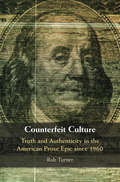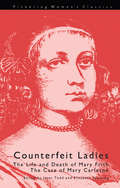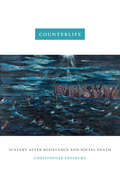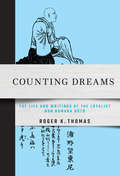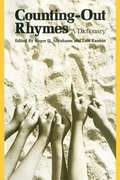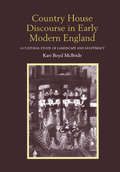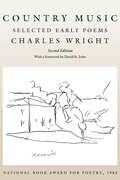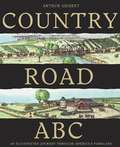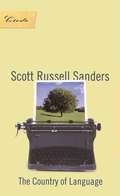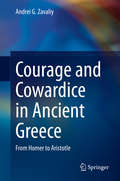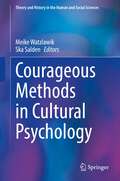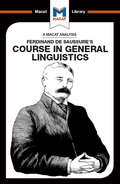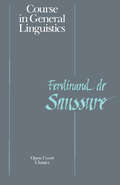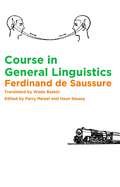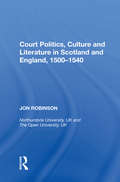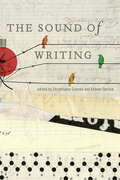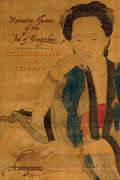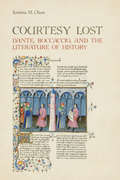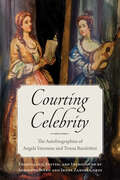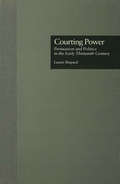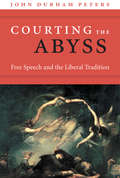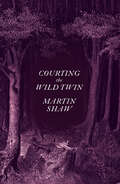- Table View
- List View
Counterfeit Culture: Truth and Authenticity in the American Prose Epic since 1960 (Cambridge Studies in American Literature and Culture #181)
by Rob TurnerCounterfeit Culture explores the possibility of writing epic in an age of alternative facts. Examining six attempts to forge an American prose epic since 1960, this study goes on to trace a national tradition of inauthenticity, stretching back across four centuries. In works by authors such as Pynchon, Gaddis and Burroughs, the contemporary turn away from truth and authenticity can be seen as a return to an established line of literary tricksters and confidence men, with tropes of fraud and artifice running deep in the American grain. Combining archival work with historically-inflected analysis of literary narrative, this book ranges through questions of identity, technology, history, and music in its engagement. From Marguerite Young's inquiry into psychological disintegration to William T. Vollmann's ongoing cycle of false histories, the study introduces a new reading of the American epic.
Counterfeit Ladies: The Life and Death of Moll Cutpurse and the Case of Mary Carleton (Pickering Women's Classics)
by Elizabeth SpearingBiographies of two 17th-century female criminals, both celebrated in their day. These are the first editions published since the 17th century.
Counterlife: Slavery after Resistance and Social Death
by Christopher FreeburgIn Counterlife Christopher Freeburg poses a question to contemporary studies of slavery and its aftereffects: what if freedom, agency, and domination weren't the overarching terms used for thinking about Black life? In pursuit of this question, Freeburg submits that current scholarship is too preoccupied with demonstrating enslaved Africans' acts of political resistance, and instead he considers Black social life beyond such concepts. He examines a rich array of cultural texts that depict slavery—from works by Frederick Douglass, Radcliffe Bailey, and Edward Jones to spirituals, the television cartoon The Boondocks, and Quentin Tarantino's Django Unchained—to show how enslaved Africans created meaning through artistic creativity, religious practice, and historical awareness both separate from and alongside concerns about freedom. By arguing for the impossibility of tracing slave subjects solely through their pursuits of freedom, Freeburg reminds readers of the arresting power and beauty that the enigmas of Black social life contain.
Countermodernism and Francophone Literary Culture: The Game of Slipknot
by Keith L. WalkerKeith L. Walker traverses the traditionally imposed boundaries of geography and race as he examines the literary culture produced by French speakers and writers born outside France. Focusing on the commonalities revealed in their shared language and colonial history, Walker examines for the first time the work of six writers who, while artistically distinct and geographically scattered, share complex sensibilities regarding their own relationship to France and the French language and, as he demonstrates, produce a counterdiscourse to their colonizers' modern literary traditions.Martinique, French Guyana, Senegal, Morocco, and Haiti serve as the stage for the struggle these writers have faced with French language and culture, a struggle influenced by the legacy of Aimé Césaire. In his stand against the modernist principles of Charles Baudelaire, Walker argues, Césaire has become the preeminent francophone countermodernist. A further examination of the relationships between Césaire and the writers Léon Gontron Damas, Mariama Bâ, Tahar Ben Jelloun, Ken Bugul, and Gérard Étienne forms the core of the book and leads to Walker's characterization of francophone literature as having "slipped the knot," or escaped the snares of the familiar binary oppositions of modernism. Instead, he discovers in these writers a shared consciousness rooted in an effort to counter and denounce modernist humanist discourse and pointing toward a new subjectivity formed through the negotiation of an alternative modernity.Countermodernism and Francophone Literary Culture will engage readers interested in French literature and in postcolonial, Caribbean, African, American, and francophone studies.
Counting Dreams: The Life and Writings of the Loyalist Nun Nomura Bōtō
by Roger K. ThomasCounting Dreams tells the story of Nomura Bōtō, a Buddhist nun, writer, poet, and activist who joined the movement to oppose the Tokugawa Shogunate and restore imperial rule. Banished for her political activities, Bōtō was imprisoned on a remote island until her comrades rescued her in a dramatic jailbreak, spiriting her away under gunfire. Roger K. Thomas examines Bōtō's life, writing, and legacy, and provides annotated translations of two of her literary diaries, shedding light on life and society in Japan's tumultuous bakumatsu period and challenging preconceptions about women's roles in the era.Thomas interweaves analysis of Bōtō's poetry and diaries with the history of her life and activism, examining their interrelationship and revealing how she brought two worlds—the poetic and the political—together. Counting Dreams illustrates Bōtō's significant role in the loyalist movement, depicting the adventurous life of a complex woman in Japan on the cusp of the Meiji Restoration.
Counting-Out Rhymes: A Dictionary
by Roger D. Abrahams Lois RankinEeny, meeny, figgledy, fig. Delia, dolia, dominig,Ozy, pozy doma-nozy,Tee, tau, tut,Uggeldy, buggedy, boo!Out goes you. (no. 129)You can stand,And you can sit,But, if you play,You must be it. (no. 577)Counting-out rhymes are used by children between the ages of six and eleven as a special way of choosing it and beginning play. They may be short and simple ("O-U-T spells out/And out goes you") or relatively long and complicated; they may be composed of ordinary words, arrant nonsense, or a mixture of the two. Roger D. Abrahams and Lois Rankin have gathered together a definitive compendium of counting-out rhymes in English reported to 1980. These they discovered in over two hundred sources from the nineteenth and twentieth centuries, including rhymes from England, Scotland, Ireland, Australia, New Zealand, and the United States. Representative texts are given for 582 separate rhymes, with a comprehensive listing of sources and variants for each one, as well as information on each rhyme's provenience, date, and use. Cross-references are provided for variants whose first lines differ from those of the representative texts. Abrahams's introduction discusses the significance of counting-out rhymes in children's play. Children's folklore and speech play have attracted increasing attention in recent years. Counting-Out Rhymes will be a valuable resource for researchers in this field.
Country House Discourse in Early Modern England: A Cultural Study of Landscape and Legitimacy
by Kari Boyd McBrideIn this study, Kari Boyd McBride defines 'country house discourse' as a network of fictions that articulated and mediated early modern concerns about the right use of land and the social relationships that land engendered. McBride provides new perspectives on the roles of the discourse she identifies, linking it with a number of larger historical shifts during the time period. Her interdisciplinary focus allows her to bring together a wide range of material-including architecture, poetry, oil painting, economic and social history, and proscriptive literature-in order to examine their complex interrelationship, revealing connections unexplored in more narrowly focused studies. McBride delineates the ways in which the country house (on the landscape and in literature) provided a locus for the construction of gender, race, class, and nation. Of particular interest is her focus on women's relationships to the country house: their writing of country house poetry and their representation in that literature; their designing of country houses and their lives within those architectural spaces (whether as lady of the house or domestic servant). One of the most important and promising insights in this study is that country house discourse was not simply static and nostalgic, but actually worked to mediate change. All in all, she presents a fresh and detailed study of the great disparities between country house reality and the ideals that informed country house discourse.
Country Mouse and City Mouse
by Megan Howard David BergsteinThe fun and excitement of English and Language Arts learning continues in Grade 2 of Reading Street. This comprehensive and dynamic curriculum for homeschooling is geared toward young children who have some foundational English and Language Arts knowledge and are ready to strengthen their skills. Comprised of engaging activities, challenging content and weekly quizzes, Reading Street: Grade 2 is the next step in your child's path toward becoming a lifelong learner and reader. As with all Reading Street products, the Grade 2 system is formatted to help students meet certain age-appropriate goals. After completing this English and Language Arts homeschool program, your child should be able to: Read and comprehend two-syllable words. Identify common prefixes (such as pre-, un-, or re-) and suffixes (such as -able, -ad and -er). Correct mistakes made when reading out loud. Read books with two or more chapters. Understand the structure of stores (i. e. beginning, middle and end). Start selecting reading materials based on his/her own interests. Identify the "who," "what," "when," "where," "why" and "how" of the text. While the goals of second Grade English and Language Arts are numerous, Reading Street will help you craft engrossing lessons. Your child will garner important English and Language Arts skills while completing a workbook, reading stories and poems, and taking assessments. Planning these lessons will be easier than ever, as all Reading Street systems are broken down into weekly Big Ideas. All the work your child does on a given week is formulated around that single concept for an organized and challenging curriculum. With six easy-to-follow units, Reading Street: Grade 2 is the perfect tool for homeschooling parents. Your child will enjoy the reading selections and activities, and you'll love to see your student growing into a knowledgeable individual. We're confident that this product is the right one for you. For more information on the specific materials found in Grade 2 of Reading Street, check out the Features and Benefits page.
Country Music: Selected Early Poems (Wesleyan Poetry Series)
by Charles WrightA compilation of powerful and moving poems from early in the poet's career. Co-winner of the 1983 National Book Award for Poetry, Country Music is comprised of eighty-eight poems selected from Charles Wright's first four books published between 1970 and 1977. From his first book, The Grave of the Right Hand, to the extraordinary China Trace, this selection of early works represents "Charles Wright's grand passions: his desire to reclaim and redeem a personal past, to make a reckoning with his present, and to conjure the terms by which we might face the future," writes David St. John in the forward. These poems, powerful and moving in their own right, lend richness and insight to Wright's recently collected later works. "In Country Music we see the same explosive imagery, the same dismantled and concentric (or parallel) narratives, the same resolutely spiritual concerns that have become so familiar to us in Wright's more recent poetry," writes St. John.
Country Road ABC
by Arthur GeisertOn today's farm, B is for barn cat...E is for erosion...G is for grinding feed, and I is for...inoculate? In 26 beautifully detailed spreads, acclaimed illustrator Arthur Geisert takes readers on a literal journey following a real road in Iowa (County Road Y31) through the ins and outs of America's farmland. This isn't your grandfather's farm book. It still features pigs, hay, and other familiar farm residents, but you'll see a very different kind of quicksand and traffic jam here...Along the bottom of each page is a continuous panorama that totals nearly forty feet of art. Country Road ABC is a unique and funny look at America's present-day farmland.
Country of Language
by Scott R. SandersScott Russell Sanders argues that people need to find a sense of "at-homeness" in the natural world because moments of interaction with the nonhuman world restore sanity and courage in the face of life's trials.
Courage and Cowardice in Ancient Greece: From Homer to Aristotle
by Andrei G. ZavaliyThe book offers the first comprehensive account of the debate on true courage as it was raging in ancient Greece, from the times when the immensely influential Homeric epics, the Iliad and the Odyssey, were composed, to the period of the equally influential author, Aristotle. The many voices that contribute to this debate include poets, authors of ancient dramas and comedies, historians, politicians and philosophers. The book traces the origin of the earliest ideal of a courageous hero in the epic poems of Homer (8th century BCE), and faithfully records its transformations in later authors, which range from an emphatic denial of the Homeric standards of courage (as in comedies of Aristophanes and some Dialogues of Plato) to the strong revisionist tendencies of Aristotle, who attempts to restore genuine courage to its traditional place as an exclusively martial, male virtue.Without attempting to cover the whole of the Western history, the book is able to explore the most important primary Greek sources on the subject matter in greater details, and provide the reader with a comprehensive picture of the changes in both popular and philosophical conceptualizations of the standards of courage from the Archaic period to the middle of the 4th century BCE. A deeper understanding of the history of the debate on courage should help to shape the modern discussions as well, as it becomes obvious that many of the questions on courage and cowardice that are still raised by the contemporary authors from different fields, have been thoroughly considered during the early stages of Greek culture. The book seeks to undermine a common stereotype of a single, unified view on courage and cowardice in Ancient Greece and shows that the current debates on what constitutes genuine courageous character can be traced to the various direct and indirect discussions on this subject matter by the ancient authorities.
Courageous Methods in Cultural Psychology (Theory and History in the Human and Social Sciences)
by Meike Watzlawik Ska SaldenInnovative research requires courageous methods. With this in mind, Courageous Methods in Cultural Psychology invites students and post-graduate researchers to develop methods that will let them grasp phenomena of interest more fully. Readers will learn how to use established methods, and may be asked to develop them further by combining single steps of extant procedures, or by taking a completely new approach to data collection and analysis. In this book, diverse researchers present projects in which they have tried to do just that. A comprehensive process — from narrowing down research questions to collecting and analyzing data — is given in detail, followed by critical reflections on how well the authors have understood and shared complex realities. Project presentations are framed by theoretical chapters that deal with the challenges and opportunities of cultural psychology and interdisciplinary research. Courageous Methods in Cultural Psychology is sure to inspire and encourage those who wish to venture on new roads “into the wild.”
Course in General Linguistics
by Brittany Pheiffer Noble Laura E.B. KeyFerdinand de Saussure’s Course in General Linguistics is one of the most influential texts of the 20th-century – an astonishing feat for what is, at heart, a series of deeply technical lectures about the structure of human languages. What the Course’s vast influence shows, fundamentally, is the power of good interpretative skills. The interpretative tasks of laying down and clarifying definitions are often vital to providing the logical framework for all kinds of critical thinking – whether it be solving problems in business, or esoteric academic research. At the time sat which Saussure gave his lectures, linguistics was a scattered and inconsistent field, without a unified method or rigorous approach. He aimed to change that by setting down and clarifying definitions and distinctions that would provide a coherent methodological framework for the study of language. The terms laid down in the Course did exactly that – and they still make up the core of linguistic terminology a full century later. More than this, however, Saussure also highlighted the centrality of linguistic interpretation to understanding how we relate to the world, founding “semiotics”, or the study of signs – a field whose influence on academics across the humanities and social sciences is unparalleled.
Course in General Linguistics
by Ferdinand La SaussureThe Cours de linguistique generale, reconstructed from students' notes after Saussure's death in 1913, founded modern linguistic theory by breaking the study of language free from a merely historical and comparativist approach. Saussure's new method, now known as Structuralism, has since been applied to such diverse areas as art, architecture, folklore, literary criticism, and philosophy.
Course in General Linguistics (Bloomsbury Revelations Ser.)
by Ferdinand de SaussureThe founder of modern linguistics, Ferdinand de Saussure inaugurated semiology, structuralism, and deconstruction and made possible the work of Jacques Derrida, Roland Barthes, Michel Foucault, and Jacques Lacan, thus enabling the development of French feminism, gender studies, New Historicism, and postcolonialism. Based on Saussure's lectures, Course in General Linguistics (1916) traces the rise and fall of the historical linguistics in which Saussure was trained, the synchronic or structural linguistics with which he replaced it, and the new look of diachronic linguistics that followed this change. Most important, Saussure presents the principles of a new linguistic science that includes the invention of semiology, or the theory of the "signifier," the "signified," and the "sign" that they combine to produce.This is the first critical edition of Course in General Linguistics to appear in English and restores Wade Baskin's original translation of 1959, in which the terms "signifier" and "signified" are introduced into English in this precise way. Baskin renders Saussure clearly and accessibly, allowing readers to experience his shift of the theory of reference from mimesis to performance and his expansion of poetics to include all media, including the life sciences and environmentalism. An introduction situates Saussure within the history of ideas and describes the history of scholarship that made Course in General Linguistics legendary. New endnotes enlarge Saussure's contexts to include literary criticism, cultural studies, and philosophy.
Court Politics, Culture and Literature in Scotland and England, 1500-1540
by Jon RobinsonThe focus of this study is court literature in early sixteenth-century England and Scotland. The author examines courtly poetry and drama in the context of a complex system of entertainment, education, self-fashioning, dissimulation, propaganda and patronage. He places selected works under close critical scrutiny to explore the symbiotic relationship that existed between court literature and important socio-political, economic and national contexts of the period 1500 to 1540. The first two chapters discuss the pervasive influence of patronage upon court literature through an analysis of the panegyric verse that surrounded the coronation of Henry VIII. The rhetorical strategies adopted by courtiers within their literary works, however, differed, depending on whether the writer was, at the time of writing the verse or drama, excluded or included from the environs of the court. The different, often elaborate rhetorical strategies are, through close readings of selected verse, delineated and discussed in chapter three on David Lyndsay and chapter four on Thomas Wyatt and Thomas Elyot.
Court Reporting: Bad Grammar Good Punctuation Workbook
by Margaret Wakeman WellsA language arts workbook for court reporting
Courteous Capitalism: Public Relations and the Monopoly Problem, 1900-1930
by Christopher Cannon and Steven JusticeCourtesans and Opium: Romantic Illusions of the Fool of Yangzhou (Weatherhead Books on Asia)
by AnonymousIn his preface, the anonymous author of Courtesans and Opium describes his book as an act of penance for thirty years spent patronizing the brothels of Yangzhou. Written in the 1840s, his story is filled with vice and dark consequence, portraying the hazards of the city's seedy underbelly and warning others against the example of the Fool.Chinese literature's first true "city novel," Courtesans and Opium recounts the illustrious career of a debauched soul enveloped by enthralling pursuits and romantic illusions. While socially acceptable marriages were arranged and often loveless, brothels offered men accomplished courtesans who served as both enchanting companions and sensual lovers. These professional sirens dressed in the latest styles and dripped with gold, silver, and jewels. From an early age, they were taught to excel at various arts and graces, which transformed the brothel into a kind of club for men to meet, exchange gossip, and smoke opium at their leisure.The Fool's fable follows five sworn brothers and their respective relationships with Yangzhou courtesans, revealing in acute detail the lurid materialism of this dangerous world—its violence and corruption as well as its seductive but illusory promise. Never before translated into English, Courtesans and Opium offers a brilliant window into the decadence of nineteenth-century China.
Courtesy Lost
by Kristina Marie OlsonIn Courtesy Lost, Kristina M. Olson analyses the literary impact of the social, political, and economic transformations of the fourteenth century through an exploration of Dante's literary and political influence on Boccaccio. The book reveals how Boccaccio rewrote the past through the lens of the Commedia, torn between nostalgia for elite families in decline and the need to promote morality and magnanimity within the Florentine Republic.By examining the passages in Boccaccio's Decameron, De casibus, and Esposizioni in which the author rewrites moments in Florentine and Italian history that had also appeared in Dante's Commedia, Olson illuminates the ways in which Boccaccio expressed his deep ambivalence towards the political and social changes of his era. She illustrates this through an analysis of Dante's and Boccaccio's treatments of the idea of courtesy, or cortesia, in an era when the chivalry of the declining aristocracy was being supplanted by the civility of the rising merchant classes.
Courting Celebrity: The Autobiographies of Angela Veronese and Teresa Bandettini (Toronto Italian Studies)
by Adrienne Ward Irene Zanini-CordiIn 1826 Angela Veronese, a gardener’s daughter, wrote and published the first modern autobiography by an Italian woman. Veronese’s account focuses on her unique experience as a peasant girl who came of age among the Venetian elite, and details how she attained a certain renown in and out of Italy by improvising, writing, and publishing her own lyrics. Courting Celebrity is a bilingual annotated edition of Veronese’s autobiography. To better elucidate Veronese’s thinking, the book includes the autobiographical writing of another contemporary Italian poet, Teresa Bandettini, a well-known Tuscan poet-improviser. The book offers a substantial sample of Veronese’s poems, translated and in the original. These compositions, together with detailed bibliographical documentation, point to the success of Veronese’s autobiographical enterprise and offer an unparalleled view of both high society and popular culture at the time. Courting Celebrity illustrates women’s practice in two key literary genres, poetry and autobiography, and illuminates the strategies of women’s self-fashioning and pursuit of celebrity.
Courting Power: Persuasion and Politics in the Early Thirteenth Century (Garland Studies in Medieval Literature #17)
by Laurie ShepardThis text chronicles a change in epistolary persuasion in the 1230's, crystallized at the imperial chancery of Frederick II, Emperor from 1220-1250. There, traditional appeals, premised on authority and harmony, were challenged by letters in which historical circumstances functioned as an integral part of the strategy of persuasion. Based on the close reading of "Artes Dictandi", as well as a series of letters issued from the papal and imperial chanceries, this book explores the theory and practice of medieval letter-writing. Letters are evaluated as verbal acts intended to persuade, with the public as the ultimate arbiter of success. The author argues that the form, proportion and style of letters were contoured by ideology.
Courting the Abyss: Free Speech and the Liberal Tradition
by John Durham PetersCourting the Abyss updates the philosophy of free expression for a world that is very different from the one in which it originated. The notion that a free society should allow Klansmen, neo-Nazis, sundry extremists, and pornographers to spread their doctrines as freely as everyone else has come increasingly under fire. At the same time, in the wake of 9/11, the Right and the Left continue to wage war over the utility of an absolute vision of free speech in a time of increased national security. Courting the Abyss revisits the tangled history of free speech, finding resolutions to these debates hidden at the very roots of the liberal tradition. A mesmerizing account of the role of public communication in the Anglo-American world, Courting the Abyss shows that liberty's earliest advocates recognized its fraternal relationship with wickedness and evil. While we understand freedom of expression to mean "anything goes," John Durham Peters asks why its advocates so often celebrate a sojourn in hell and the overcoming of suffering. He directs us to such well-known sources as the prose and poetry of John Milton and the political and philosophical theory of John Locke, Adam Smith, John Stuart Mill, and Oliver Wendell Holmes Jr., as well as lesser-known sources such as the theology of Paul of Tarsus. In various ways they all, he shows, envisioned an attitude of self-mastery or self-transcendence as a response to the inevitable dangers of free speech, a troubled legacy that continues to inform ruling norms about knowledge, ethical responsibility, and democracy today. A world of gigabytes, undiminished religious passion, and relentless scientific discovery calls for a fresh account of liberty that recognizes its risk and its splendor. Instead of celebrating noxious doctrine as proof of society's robustness, Courting the Abyss invites us to rethink public communication today by looking more deeply into the unfathomable mystery of liberty and evil.
Courting the Wild Twin
by Martin Shaw"Fabulous."—Dan Richards, author of Holloway"Terrifically strange and thrilling."—Melissa Harrison, author of All Among the Barley"A modern-day bard."—Madeline Miller, author of CirceThis is a book of literary activism – an antidote to the shallow thinking that typifies our age. In Courting the Wild Twin, acclaimed scholar, mythologist and author of Smoke Hole and Bardskull, Martin Shaw unravels two ancient European fairy tales concerning the mysterious &‘wild twin&’ located deep inside all of us. By reading these tales and becoming storytellers ourselves, he challenges us to confront modern life with purpose, courage, and creativity.Martin summons the reader to the "ragged edge of the dark wood" to seek out this estranged, exiled self – the part we generally shun or ignore to conform to societal norms – and invite it back into our consciousness. If there was something we were meant to do with our few, brief years on Earth, we can be sure that our wild twin is holding the key.After all, stories are our secret weapons – and they might just save us.
